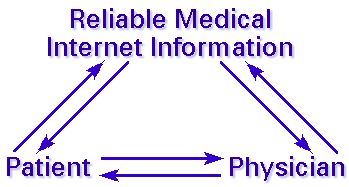
The full web page version can be found at: http://www.journeyofhearts.org/jofh/about/triad. Triad of Medical Web-Education
Web-education is a term we have coined to describe the process of teaching/educating people using information and resources from the Internet. Web-education can be applied to a variety of settings, from distant learning courses to use of the Internet in the classroom. However, our special interest is in the application of Web-education within the field of medicine. Medical Web-education consists of three inter-related components (Diagram 1):
Diagram 1
The role of the physician in dealing with the medical Internet is changing. We cannot continue to pretend that it doesn't exist, or that or patients aren't using this new technology. Ideally physicians should be educating their their Internet-using patients on the best use of the Internet including:
Advantages of Using a Website for Patient Web-Education With the growing need to provide more patient education but with less time and resources to do so, a website is an obvious resource that a physician can utilize to supplement the patient education already started in the office setting. There are several obvious advantages for using a website for educating patients:
2. A website can be accessed from home, when a person is receptive. 3. Information can be updated immediately. 4. There is an abundance of patient education materials available on the Internetnbsp; 5. The Internet levels the playing field making the same information accessible to anyone with access to a computer. 6. A website can be accessed by patients to clarify, augment or reinforce information presented in an office visit. 7. A website can be experienced in a variety of ways--through colors, sounds, and images in addition to reading content on the site. 8. Via Internet connectivity, websites can reach those in rural communities and under-served areas, or facilities with limited consultants and libraries, to provide them with access to the most current on-line resources, journals and textbooks. 9. With no state, national or international boundaries on the Internet, this allows for connecting patients and practitioners who have similar experiences, are dealing with rare diseases, or have expertise in a particular area, throughout the world to share medical information and support. This article originally appeared
in the November 1, 1999 issue of The CyberMed Catalyst: Journal of the
Alliance of Medical Internet Professionals. (JAMIP). © 1999 Kirsti
A. Dyer, MD, MS, BCBT, Cole D. Thompson, MA & JAMIP.
Kirsti A. Dyer,
MD, MS
A single copy can be made for personal or professional use. Contact Dr. Dyer at griefdoc@journeyofhearts.org for permission to use materials from this website for other ventures. |
